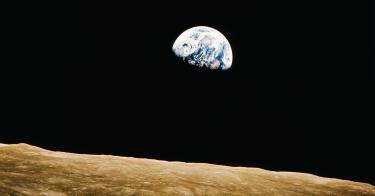“In the beginning, God created the heaven and the earth. And the earth was without form, and void; and darkness was upon the face of the deep.” So began the momentous Christmas broadcast on Dec. 24, 1968—the most watched television program in history at that time—when astronauts Frank Borman, James Lovell and Bill Anders read verses from the book of Genesis as they became the first humans in history to leave earth orbit and circle the moon.
As so many of us in this country and others around the world are home with our families this Christmas season, we should remember these three intrepid, brave American explorers and the thousands of engineers, scientists and technicians who made their flight possible.
Fifty-one years ago, these astronauts captured the first photograph of the Earth rising in the void and darkness of the heavens at a very special time, a holiday where Christians around the world celebrate the birth of Jesus and wish for peace on Earth and good will toward men, of which there is sadly too little in our everyday lives.
That haunting and profoundly moving photograph shows a precious and fragile jewel. But it is also an exquisite orb filled with the beautiful blues of the oceans and full of the light that, as Anders read, “God moved upon the face of the waters.”
Apollo 8 launched on Dec. 21, 1968, in a spectacular cloud of flame from the Kennedy Space Center at Cape Canaveral. It was only the second manned launch to lift off from the Cape after the tragic cabin fire in the Apollo 1 command module that killed Gus Grissom, Ed White and Roger Chaffe.
This mission followed the October flight of Apollo 7, with Walter Schirra, Walter Cunningham and Donn Eisele, that circled the Earth as the first crewed Apollo mission. Apollo 7 made the first television broadcast from space, something we take for granted today.
The purpose of the Apollo 8 mission was to test everything from the basic functioning of the equipment to the ability to successfully navigate a manned spacecraft to our nearest neighbor in space and get back safely. This was an achievement that no one but a few dreamers had believed was even technologically feasible just a short time before. It was one of the most remarkable accomplishments in the history of our living on this planet we call home.
The Apollo 8 spacecraft took almost three days to reach its destination and insert itself into an orbit around what Shakespeare called an “arrant thief” whose “pale fire she snatches from the sun.” Sixty-nine hours into the mission, Borman, Lovell and Anders saw something that no one had ever seen before—the dark side of the moon, where there is no “pale fire” from the sun.
Those daring Americans spent 20 hours circling the moon, getting as close as 70 miles to the surface. At the end of their 10th lunar orbit, they fired their rockets for three minutes and 23 seconds to leave that world and come back to ours.
They reentered the earth’s atmosphere on Dec. 27 after six days and three hours in space, having travelled almost 580,000 miles. The capsule splashed down in the Pacific Ocean where they were recovered by the USS Yorktown, the renowned aircraft carrier commissioned in 1943 to replace the carrier of the same name that was lost during the Battle of Midway in 1942.
Their speed when they returned was an almost unimaginable 25,000 miles per hour—seven miles every second. As the spacecraft plunged through the atmosphere, the precious layer that protects us from the cold void of the heavens and makes life possible on this sapphire oasis, the temperature on the heat shields reached 5,000 degrees.
Designing a spacecraft that could survive reentry is another remarkable achievement of American engineers. Diamonds, the hardest substance known to man, start to burn at about 1,300 degrees. Steel melts at 2,500 degrees, only half of the temperature that Apollo 8 experienced. Borman, Lovell and Anders ended their historic Christmas broadcast with this:
“And from the crew of Apollo 8, we close with good night, good luck, merry Christmas—and God bless all of you, all of you on the good Earth.” I can’t think of a better blessing than that during this holiday season. So in 2019, Merry Christmas to all of you and God bless all of us on the good Earth.
This piece was originally distributed by Tribune News Service on 12/24/19




